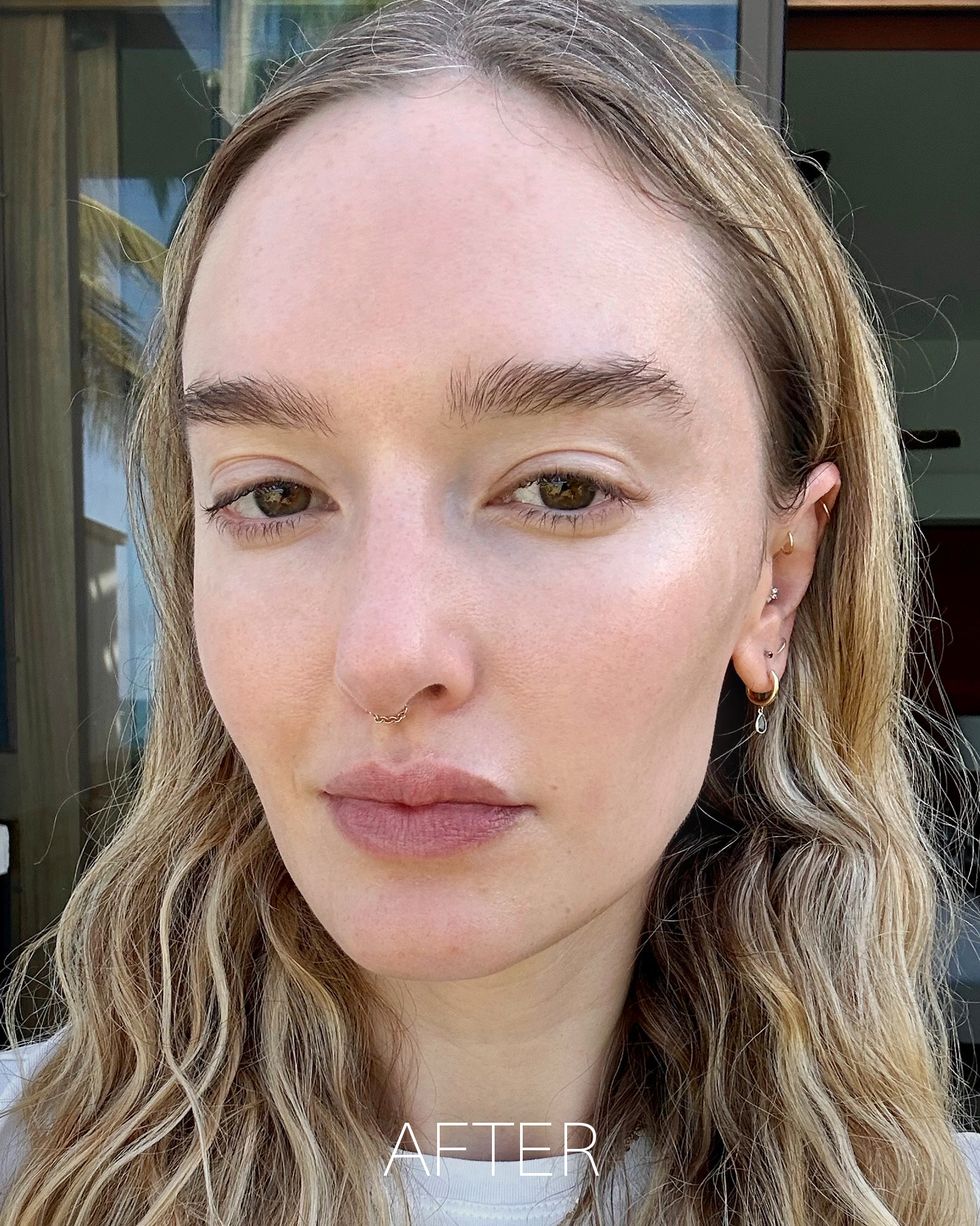Products You May Like
Dark spots are the bane of my existence. Despite working as a beauty editor for the last decade, with access to every snazzy new product that promises to even out skin tone, I still woke up in my early 30s with a complexion riddled with melasma. I’m also not the only one. A 2017 study found that up to 50 percent of people in certain geographical locations (melasma is more prevalent with exposure to sunlight) deal with this pesky form of hyperpigmentation, which is also notoriously difficult to treat.
“Melasma causes blotchy, discolored patches to appear on the skin,” explains Chaneve Jeanniton, MD, a board-certified oculofacial plastic surgeon and founder of epi.logic skincare. “It typically occurs on the face and is symmetrical, affecting the cheeks, forehead, and upper lip.” She adds that although melasma will look different on someone with a lighter skin tone versus someone with more melanin, the degree of darkening will remain relative to the person’s base skin tone. For myself, with my Western European heritage, that means my otherwise pale complexion develops almond-brown patches across those three facial areas every summer and fall like clockwork. Fun stuff!
Unfortunately, genetics are only half the battle when dealing with melasma. Dr. Jeanniton says that hormones, specifically estrogen and progesterone, and lifestyle factors, like UV exposure, can also trigger the development of melasma. “Although still debated, stress seems to trigger melasma due to increased cortisol,” she adds. Like any 34-year-old woman on planet Earth, stress is simply an unavoidable fact of life, so the idea of minimizing it along with all the other potential melasma culprits can feel particularly insurmountable.
“Melasma is challenging to treat for several reasons,” says Macrene Alexiades, MD, PhD, FAAD, a double-board certified dermatologist and founder of Macrene Actives. She cites the depth of the pigmentation, the condition’s chronic nature, hormonal fluctuations, and variable response to treatment as the main complications when addressing melasma. But even this laundry list of roadblocks couldn’t deter me from trying to achieve even-toned and preternaturally glowy skin. If the celebrity set can do it (at least according to all those popular “makeup-free” mornings we see on TikTok), then so can I. This time, however, I turned to the pros for help.
Start with Topical Products for Melasma
Mild cases of melasma, aka those that are still in the early stages and fairly superficial, can achieve significant lightening with the use of topical products. Both Dr. Jeanniton and Dr. Alexiades suggest that patients try products with specific active ingredients before turning to more invasive options. “The gold standard topical treatment for melasma is a prescription cream consisting of a triple combination of tretinoin, hydroquinone, and corticosteroid,” says Dr. Jeanniton. However, hydroquinone (a skin-lightening agent) can worsen hyperpigmentation in patients with deeper skin tones.
If you’d rather not obtain a subscription, or if hydroquinone is too risky to use for your skin tone, she suggests trying products that contain targeted pigment-reducing actives such as retinoids — like epi.logic Double Feature — tranexamic acid — like Topicals Faded Serum — niacinamide — like Maelove NIA 10 Serum — and alpha-hydroxy acids, like the U Beauty Resurfacing Compound. Of course you’ll want to ensure you’re not using these types of products in rapid succession as that’s a surefire way to cause skin inflammation. Start with one or two on alternating days a few times per week to keep irritation at bay, then work your way up from there to see more significant results.
Visit a Professional for a Chemical Peel
Once melasma reaches a deeper component in the skin, down past the epidermis to the dermis, it is categorized as moderate to severe and is thus more difficult to treat. And if, like me, you have struggled with chronic, recurring melasma for many years, professional intervention is likely the best course of action.
It’s tempting to try one of the numerous at-home chemical peel products on the market right now, but they might not be the right avenue for treating your melasma. “I’d advise to stay away from performing at-home chemical peels if you’re dealing with melasma,” says Dr. Jeanniton. “They can trigger melasma and make the hyperpigmentation worse and more difficult to treat.” Instead, book an appointment with your favorite facialist to experience a professional level glycolic (or other alpha-hydroxy acid) peel. A board-certified plastic surgeon or dermatologist will also offer professional peels that suit your skin without exacerbating preexisting dark spots.
I’ve tried peels in the past with varying levels of success, but after a summer with (too much) sun exposure, I decided to visit Dr. Alexiades at her Manhattan practice to explore an alternative treatment.
Try a Laser Treatment for Melasma, but Be Wary
Skincare lasers are all the rage, but just because your provider has a fancy machine in her office doesn’t mean it’s the best option to address melasma. As Dr. Alexiades explains, “Certain laser treatments can actually worsen melasma” since these types of energy devices generate heat, which in turn triggers inflammation and melanocyte production (the cells that give your skin its color). She suggests looking for providers that have either a Q-Switched or a Picosecond Nd:YAG laser. For my treatment, we went with the latter.
“Picogenesis at 1064 nanometers allows for the delivery of this laser wavelength at picosecond pulse durations,” says Dr. Alexiades. “It breaks up the pigment in a subcellular, gentle manner without overly heating or killing the cells. This results in a gradual reduction in the abnormal pigment in melasma while leaving your normal skin alone.”
To achieve the maximum lightening possible, Dr. Alexiades delivers three Pico laser treatments spaced four weeks apart, starting in October, which she describes to her celebrity clientele as the start of “Pico season.” She explains, “My mandatory rule is no sun exposure four weeks prior and four weeks after each treatment. This allows for a tan to fade adequately so that the laser can target the abnormal pigment and leave your underlying pigment alone. October gives me a chance to get in three monthly treatments before December when people go on vacation again.”
Luckily, the treatment itself isn’t painful — rather, it feels like the briefest snap of a rubber band against your skin. Once I popped on the very chic protective goggles, I could hold a conversation without grimacing for the full five minutes it took Dr. Alexiades to zap my cheeks, upper lip, and forehead. It’s also a safe option for all skin tones, which isn’t typically the case with lasers. “I have safely treated very deeply pigmented skin and simply adjusted my fluence and pass count,” says Dr. Alexiades. Be sure to visit a provider with experience in treating your skin tone to ensure you receive the best possible results.
Maintain Your Results and Keep Melasma at Bay
Afterwards, my skin was slightly red, but nothing compared to getting radiofrequency microneedling. By the time I returned to my apartment, you’d never know I had received a powerful laser treatment. The additional aftercare is also minor but extremely important. Sun protection is non-negotiable, and Dr. Alexiades urged me to reach for an SPF 100 option, like the La Roche-Posay Anthelios Melt-In Milk Sunscreen for Face & Body SPF 100.
By the end of my third session, I could barely fathom how even-toned my skin looked. The relentless darkening along my cheekbones finally matched my jawline and the smattering of dark spots on my forehead were nowhere to be found. My complexion truly looked, as Dr. Alexiades promised, like butter.
I’d love to say that by the time I, or anyone else struggling with melasma, walks out the door after a professional treatment the pigmentation doesn’t return, but few things in skin care are that simple. Unfortunately, as Dr. Jeanniton explains, “Even if we’re able to clear the hyperpigmentation, there’s still susceptibility for it to return. That’s why if you’re prone to melasma, it’s particularly important to take both a preventative and defensive approach, especially during the summer months, to keep the condition in check.”
This means diligently using sun protection (SPF and protective clothing) and applying maintenance products with active ingredients to exfoliate and brighten the skin. And if the dark spots return, as mine are sure to, keep a standing yearly appointment with your favorite skincare provider for your choice of laser or chemical peel. Yes, it’s not always the cheapest option (Pico lasers at Dr. Alexiades’ office will run you around $1,000 per session), but if few other treatments have worked for your skin, I can attest the results are definitely worth budgeting for.

Hannah Baxter is a beauty and wellness writer, consultant, and the former deputy beauty editor at The Zoe Report, where she oversaw the site’s beauty vertical. Previously, she was senior beauty editor at Coveteur, and now regularly contributes to outlets including Allure, Byrdie, Harper’s Bazaar, Glamour, Bustle and more. She’s also the founder of Anxiety Beer, a bi-monthly newsletter that destigmatizes conversations around mental health.




